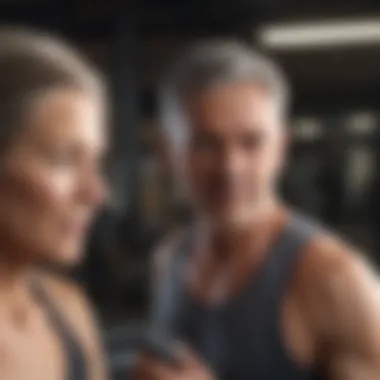Geriatric Fitness: Enhancing Quality of Life


Intro
Geriatric fitness is a concept that has gained recognition in recent years, largely due to the aging population worldwide. As individuals reach older ages, maintaining fitness becomes not just a matter of physical capability, but also an essential part of overall health and well-being. This exploration takes a close look at the myriad factors influencing fitness in older adults, presenting a detailed overview that encompasses physiological aspects, tailored exercise routines, and the essential role of healthcare professionals.
Understanding geriatric fitness is critical, as it encompasses more than just exercise. It includes nutritional health, mental well-being, and social engagement. Each component contributes to a better quality of life, reducing risks of chronic disease and enhancing mobility and functionality.
With the aim of providing a comprehensive guide, this article will address various important topics related to geriatric fitness. From examining tailored exercise programs to discussing the common challenges faced by older adults, the significance of such information becomes increasingly apparent. It will highlight not only the benefits of an active lifestyle but also how informed healthcare professionals can effectively support this demographic in their fitness journey.
Understanding Geriatric Fitness
Geriatric fitness is a vital topic in today's aging society. This section seeks to clarify its significance, particularly as it relates to older adults. The aim is to outline how understanding geriatric fitness can lead to better health outcomes, improved quality of life, and greater longevity. As individuals age, their physiological capabilities change, making it essential to adopt fitness strategies that cater specifically to their needs.
Defining Geriatric Fitness
Geriatric fitness refers to the tailored approach of physical activity and exercise designed for older adults. It encompasses various aspects, including strength, endurance, balance, and flexibility. As older adults face unique challenges, geriatric fitness is not just about maintaining physical health but also about enabling them to engage in everyday activities safely and confidently. This approach recognizes that fitness means different things at different life stages and that older adults often require specific considerations related to their health status, physical limitations, and overall well-being.
The Aging Process and Physical Activity
The aging process significantly influences the relationship between older adults and physical activity. Many individuals experience a decline in various physical capabilities as they age. However, engaging in regular exercise is proven to mitigate some of these effects. Studies show that regular physical activity can slow the aging process, reduce the risk of chronic diseases, and enhance mental agility. Understanding the aging process in relation to fitness is crucial to developing effective programs that cater to the older population’s specific needs.
Physiological Changes in Older Adults
Older adults go through several physiological changes that impact their fitness needs. These changes include multiple dimensions such as decreased muscle mass, lower bone density, and altered cardiovascular function. Importantly, these deteriorations can affect mobility, balance, and overall health. By acknowledging these physiological shifts, fitness programs can be better designed to enhance strength, flexibility, and balance, helping to keep seniors active and reduce the risk of falls and injuries.
"Engaging older adults in fitness activities significantly contributes to their overall health and can lead to a more independent lifestyle."
The Importance of Geriatric Fitness
Geriatric fitness is essential for promoting well-being in older adults. Aging comes with various physical and psychological changes. As these changes occur, physical activity often takes on new importance. A structured fitness regime can greatly enhance overall health, stave off degenerative conditions, and improve the quality of life.
Enhancing Quality of Life
Fitness greatly contributes to the quality of life for seniors. Regular physical activity promotes independence. Many older adults experience mobility issues or limitations. It is paramount that they engage in fitness to combat these challenges. Many studies indicate a clear link between consistent exercise and improved mobility, strength, and balance. This ultimately leads to greater autonomy.
Additionally, engaging in fitness activities serves a social function. Many community centers offer group exercise classes tailored for seniors. This fosters social interaction, which can effectively combat feelings of isolation. When older individuals feel connected and socially engaged, their overall life satisfaction improves.
Preventing Chronic Diseases
A significant amount of research shows that physical inactivity leads to chronic diseases. Conditions such as heart disease, diabetes, and arthritis are prevalent among older adults. Regular exercise is a crucial tool for prevention and management of these diseases. It improves cardiovascular health, regulates blood sugar levels, and enhances joint flexibility.
Moreover, maintaining any form of exercise helps in weight management. Obesity can exacerbate health concerns in older adults. Engaging in activities like walking, cycling, or swimming plays a critical role in maintaining a healthy weight. Therefore, structured exercise programs can reduce the risk of developing chronic diseases significantly.
Promoting Mental Well-being
Fitness is also beneficial for mental health. Exercise releases endorphins, which are known to elevate mood. The psychological benefits are clear – reduced symptoms of anxiety and depression are often observed in individuals who stay active. For seniors navigating life changes such as retirement or loss of loved ones, such effects can be immensely valuable.
Furthermore, engaging in physical activity can enhance cognitive function. Some studies suggest that regular exercise may even lower the risk of Alzheimer’s disease and other forms of dementia. Keeping both body and mind active leads to a holistic approach to health that contributes to prolonged wellness and longevity in older adults.
Regular physical activity can transform the quality of life for seniors, making it a key component of healthy aging.
Components of Geriatric Fitness


Understanding the components of geriatric fitness is essential for fostering health and well-being in older adults. These components include aerobic fitness, muscle strength and endurance, and flexibility and balance. Each element plays a vital role in enhancing mobility, reducing the risk of falls, and improving overall quality of life. By focusing on these aspects, seniors can experience increased functionality in daily activities and greater independence.
Aerobic Fitness
Aerobic fitness refers to the ability of the heart, lungs, and muscles to work together efficiently during sustained physical activity. This component is crucial for older adults because it improves cardiovascular health, enhances stamina, and supports metabolic function. Incorporating aerobic exercises into a senior's routine can help maintain an optimal weight and reduce the risk of chronic diseases such as heart disease and diabetes.
Regular aerobic activities might include walking, swimming, or cycling. These exercises can be adapted to suit individual capability and preferences. Not only does aerobic fitness help in physical health, but it also positively impacts mental well-being, promoting mood improvement and cognitive function.
Muscle Strength and Endurance
Muscle strength and endurance are fundamental for daily tasks. Older adults often face muscle atrophy, which can limit their ability to perform essential activities like lifting grocery bags or climbing stairs. Strength training can counteract this phenomenon, focusing on both building and maintaining muscle endurance.
Engaging in resistance exercises, such as using weights or resistance bands, enhances muscle function and helps in maintaining joint stability. This ultimately leads to better mobility and reduced injury risk. Moreover, strength training has shown to improve metabolic health and can even contribute to bone density preservation, mitigating age-related osteoporosis.
Flexibility and Balance
Flexibility and balance are two components that are often overlooked but are critical for seniors. As individuals age, flexibility tends to decrease, which can lead to stiffness and discomfort. Balance is crucial for preventing falls, a significant concern for older adults. Incorporating stretching and balance-related exercises into a fitness regimen can greatly enhance safety and mobility.
Activities like yoga, tai chi, or simple stretching exercises can bolster flexibility while also improving balance. These practices promote mindfulness and body awareness, which can boost confidence in movement. Additionally, enhancing flexibility and balance can lead to improved posture and a more refined motor control, allowing seniors to navigate their environments more safely.
"Promoting aerobic fitness, muscle strength, and balance is essential to support the overall functional independence of older adults."
Tailored Exercise Programs for Seniors
With the increasing recognition of geriatric fitness, tailored exercise programs have gained importance. These programs are essential for addressing the distinct capabilities and limitations of older adults. A one-size-fits-all approach does not comfortably suit their needs. Different seniors have varying levels of fitness, medical backgrounds, and personal goals. Thus, developing individualized fitness plans becomes fundamental.
Developing Individualized Fitness Plans
Creating individualized fitness plans involves a detailed assessment of each senior's current fitness level and health status. This critical step ensures that the training does not aggravate existing health issues. Individuals could be monitored through comprehensive evaluations which may include physical function tests, mobility assessments, and discussions about health history. For instance, someone recovering from surgery may need completely different guidelines compared to an active older adult.
When crafting these plans, it’s also important to set realistic and achievable goals. Seniors should feel a sense of accomplishment without risking injury or undue fatigue. Plans may incorporate various activities such as strength training, flexibility exercises, and aerobic workouts, ensuring a holistic approach.
Incorporating Low-Impact Activities
Low-impact activities are beneficial for older adults. They promote cardiovascular fitness while minimizing joint stress. Examples include swimming, cycling, and walking. Such exercises can be less intimidating and more enjoyable. Integrating low-impact activities into the fitness regime also encourages seniors to remain active longer. Low-impact exercises have the added advantage of being easily adjusted to fit individual comfort levels. Thus, they can significantly reduce the likelihood of injury, while still providing a solid workout.
Potential low-impact routines could include:
- Water aerobics: Ideal for those with arthritis or joint pain.
- Yoga: Enhances flexibility and promotes relaxation.
- Pilates: Strengthens core muscles while improving posture.
Group Exercise Versus Individual Training
The debate surrounding group exercise versus individual training for seniors is ongoing. Both formats have their unique advantages. Group exercises foster a sense of community and motivation. They can encourage social interaction, reducing feelings of isolation among seniors. This communal aspect often makes regular attendance more enjoyable.
On the other hand, individual training allows for customized attention. Individual programs can closely monitor progress and make necessary adjustments. This attention helps ensure that exercises are performed safely and effectively.
In practice, a blend of both approaches may be most beneficial. Group classes can provide engagement and encouragement, while individual sessions focus on specialized needs. Striving for variety in exercise regimens can also keep seniors more engaged and motivated.
"Tailored exercise programs not only enhance physical health but also contribute to mental well-being and social engagement for seniors."
Creating tailored exercise programs is an indispensable aspect of promoting geriatric fitness. By considering a senior's unique needs and preferences, healthcare professionals can help older adults maintain an active lifestyle and improve their overall well-being.


Challenges in Geriatric Fitness
Understanding the challenges faced in geriatric fitness is crucial for the continued enhancement of health among older adults. These obstacles can influence the participation levels in physical activities, which in turn affects overall well-being. By shedding light on these challenges, many of which stem from physical, psychological, and socioeconomic factors, we can better tailor interventions that promote active living for seniors.
Physical Limitations and Health Conditions
Older adults often deal with various physical limitations that can complicate their ability to engage in regular exercise. Conditions such as arthritis, osteoporosis, and cardiovascular diseases are prevalent among this demographic. These limitations can cause pain or hinder mobility, which may discourage seniors from exercising. Moreover, balance issues or frailty contribute to a heightened risk of falls, making activities seem daunting.
Addressing these concerns requires not only specialized fitness programs but also an understanding of how to adapt exercises to the unique needs of individuals. Functional assessments by healthcare professionals can help identify specific limitations, allowing for customized fitness plans that emphasize safety and gradual progression.
Psychological Barriers to Exercise
Beyond physical hurdles, psychological barriers can significantly impede participation in fitness routines for older adults. Feelings of anxiety, depression, or a lack of motivation can arise due to various factors. A common issue is the fear of injury or falling, which can make seniors reluctant to attempt exercises that could enhance their strength and stability.
Additionally, previous negative experiences with exercise can lead to a faulty perception of their abilities. Seniors may feel out of touch with their once-active self or believe they are no longer capable of physical exertion. Overcoming these barriers often requires a supportive environment and encouragement from family, friends, and health professionals. It is imperative to foster realistic expectations and celebrate small successes to build confidence in one's physical abilities.
Socioeconomic Factors Affecting Participation
Socioeconomic factors play a notable role in determining access to fitness resources for seniors. Financial constraints can limit the availability of health programs, gym memberships, or even transportation to exercise facilities. For many older adults living on fixed incomes, the costs associated with fitness programs can be prohibitive.
Limited access to safe spaces for exercise, such as parks or community centers, may also pose challenges. Not all seniors live in neighborhoods that provide accessible walking paths or fitness facilities. In addition, educational disparities can hinder knowledge about the importance of fitness or how to engage in it effectively. Addressing these socioeconomic barriers necessitates community involvement to develop inclusive programs that can reach all seniors, regardless of their financial or environmental circumstances.
"The challenges of geriatric fitness are varied but not insurmountable. Tailored approaches can transform obstacles into pathways for improved health."
Proactively tackling the challenges outlined above can pave the way for enhanced geriatric fitness, ensuring that older adults have the opportunity to enjoy happier and more fulfilling lives through consistent physical activity.
The Role of Healthcare Professionals
The involvement of healthcare professionals in geriatric fitness is paramount. They play a critical role in ensuring the well-being of older adults by integrating fitness into their overall health management plans. Their expertise allows for tailored guidance, which is essential given the varied physical conditions and lifestyles of seniors. These professionals not only assess fitness levels but also safeguard against injuries during exercise. This partnership can lead to significant improvements in both physical and mental health for the elderly.
Assessing Fitness Levels in Older Adults
Assessment is the first step toward effective geriatric fitness. Healthcare professionals employ a variety of tools and techniques to evaluate the current fitness levels of older adults. This may include physical exams, mobility assessments, and strength testing. Evaluations often involve straightforward functional tests, like the Timed Up and Go test, which gauge balance and agility. Through these assessments, professionals can recognize individual strengths and limitations, which is crucial for formulating personalized exercise plans. Regular evaluations help track progress over time, making adjustments necessary for continual improvement.
Guiding Safe Exercise Practices
Guiding safe exercise is another pivotal function of healthcare providers. Older adults may harbor concerns about engaging in physical activity, particularly if they have existing health conditions. Professionals educate seniors on how to exercise safely, emphasizing low-impact activities like swimming or walking. They also instruct on correct form and techniques to minimize injury risk. Additionally, healthcare providers offer insights on adaptive equipment, which can further enhance safety and mobility. By instilling confidence in older adults regarding exercise, they can foster a more active lifestyle.
Encouraging Lifelong Physical Activity
Healthcare professionals also have the unique opportunity to promote lifelong physical activity. They can initiate discussions on the importance of regular exercise during routine visits. This ongoing dialogue can significantly impact an individual’s commitment to fitness. Professionals are in a position to share research findings that illustrate the long-term benefits of an active lifestyle, such as reduced risk of chronic diseases, enhanced mood, and improved cognitive function. Encouraging participation in community fitness programs can also help maintain accountability.
"Engaging in regular physical activity contributes to a healthier, happier life for older adults."
By providing education and motivation, healthcare professionals create a supportive environment where seniors feel empowered to remain active throughout their later years.
In summary, the role of healthcare professionals in geriatric fitness cannot be understated. Their strategies for assessing fitness levels, advising on safe exercise practices, and championing lifelong activity are foundational to enhancing the overall quality of life for older adults.
Community Resources and Support
The exploration into geriatric fitness reveals that supportive environments are essential for older adults to maintain active lifestyles. Community resources and support play a vital role in enhancing their fitness journeys. These resources not only provide access to physical activities but also foster social interactions that are critical for mental well-being. Understanding what these resources entail can help seniors and their caregivers make informed decisions.


Local Fitness Programs for Seniors
Local fitness programs provide a structured approach for older individuals to engage in physical activity. Tailored classes, often led by trained professionals, offer various exercise options such as yoga, aquatics, and low-impact aerobics. These programs are designed to meet the unique needs of seniors, taking into account their physical limitations and health conditions.
Some benefits of local fitness programs include:
- Social Interaction: Engaging with peers in a group setting enhances motivation and reduces feelings of isolation.
- Expert Guidance: Access to skilled instructors helps ensure that exercises are performed safely, minimizing the risk of injury.
- Community Connection: These programs nurture a sense of belonging, which is crucial for emotional health.
It is useful to check community centers, senior centers, or local health facilities. Many of these institutions offer programs at various skill levels, making fitness more inclusive.
Online Resources and Virtual Training
In recent years, online resources have transformed how seniors approach fitness. Virtual training and fitness programs offer flexibility by allowing older adults to exercise from home. These platforms host videos or live classes that seniors can follow at their own pace.
Key advantages of online resources include:
- Convenience: Older adults can choose the time and pace that works best for them.
- Diverse Options: There are various types of workouts available, from strength training to meditation sessions.
- Cost-Effectiveness: Many online resources are free or available at a lower cost than in-person classes.
Platforms like YouTube provide numerous workout videos tailored for seniors, catering to varied levels of fitness. This virtual aspect has made it easier for seniors to incorporate exercise into their daily routines, regardless of their mobility and health conditions.
Peer Support Groups for Motivation
Motivation can often wane as individuals age. Peer support groups carry significant importance in sustaining enthusiasm for fitness. These groups consist of individuals who share similar interests and experiences, thus providing mutual encouragement.
The key benefits of joining peer support groups include:
- Shared Goals: Setting fitness objectives alongside peers can promote accountability.
- Helpful Feedback: Members can share insights and tips on overcoming challenges faced during fitness journeys.
- Emotional Support: Participants can provide emotional backing, fostering resilience which is essential for long-term commitment.
Platforms like Facebook host groups specifically for seniors' fitness, where members can exchange ideas, challenges, and successes. Engaging in these communities bolsters motivation and instills a sense of purpose.
"Fitness is not just about the body; it’s about the community and support that uplift the spirit."
The Future of Geriatric Fitness
The future of geriatric fitness holds significant potential to enhance the lives of older adults. As the population ages, a greater emphasis on physical health for seniors will become increasingly critical. This future involves not only advancing technology but also adapting research and policies to support an active and healthy lifestyle for older individuals. Addressing these dimensions is essential in promoting overall well-being and maintaining independence.
Innovations in Fitness Technology
Innovations in fitness technology play a crucial role in shaping the future of geriatric fitness. Wearable devices like fitness trackers and smart health monitors provide real-time feedback, allowing seniors to track their activity levels, heart rate, and overall health statistics. These devices can motivate older adults to engage more actively in their exercise routines.
Additionally, virtual reality (VR) and augmented reality (AR) have begun to emerge in the fitness community. Such technologies can create engaging, interactive experiences that encourage physical activity without the risks associated with traditional environments. For example, some programs allow seniors to participate in virtual group classes from the comfort of their homes.
Research Trends in Aging and Fitness
Research in the field of aging and fitness is evolving rapidly. Studies are now focusing on the specific physical and mental health benefits of different types of exercise regimes for older adults. Topics such as strength training’s impact on muscle preservation in aging populations and the cognitive benefits of regular aerobic activities are gaining traction.
Furthermore, interdisciplinary research is being conducted, correlating physical fitness with mental health outcomes. Ongoing studies indicate a strong link between regular physical activity and decreased occurrences of depression and anxiety among seniors. This enhanced understanding could lead to more evidence-based practices in prescribing exercise to improve quality of life.
Policy Implications for Senior Fitness Programs
Policy implications play an essential role in determining how accessible fitness programs are for seniors. Governments and organizations must recognize the importance of funding and supporting initiatives that promote geriatric fitness. This includes subsidizing membership costs for senior fitness centers, funding community exercise programs, and ensuring public spaces are safe and suitable for older adults to engage in physical activity.
Moreover, it is crucial to establish guidelines that encourage healthcare professionals to include fitness as part of standard care for older adults. Training for professionals on geriatric fitness should be integrated into medical education programs. By prioritizing physical activity at all levels, policies will foster a supportive environment for seniors aiming to maintain or improve their physical health.
The future of geriatric fitness intertwines technology, research, and policy to create an empowering space for older adults engaged in active living.
Ultimately, focusing on these key areas will help ensure that geriatric fitness remains a priority in health discussions, paving the way for healthier, more engaged elderly populations.







